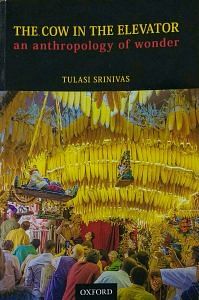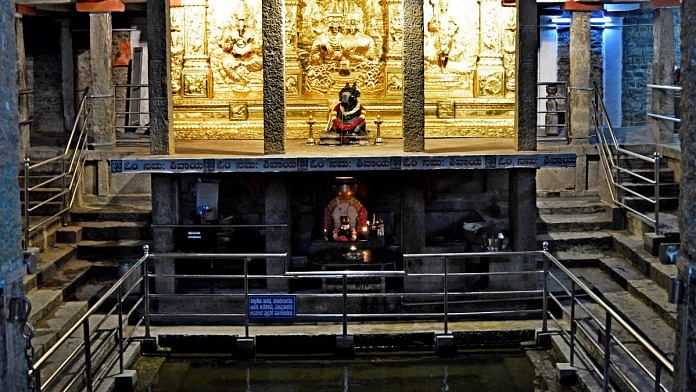In borrowed chappals I stood in an ordinary-looking coconut orchard on Temple Street in Malleshwaram, at the base of the Kadu Malleshwara spine of hills, facing the low-slung granite walls of a temple barely eight feet high. “Ayyooo! Accariyama irrukke (Tamil: It’s simply astonishing),” I heard. Vasudeva, a friend and colleague of Anand who had met us that evening at the Skyye bar, waved his arms to indicate just how astonished he was. “I did not know this temple was here. But why me alone? Nobody knew!” The temple seemed to be crouching in the orchard, its unusual square shape and low spire matching its small tight wooden door. Unusual for Bangalore, we could hear the gush of overflowing water nearby mimicking the expected sounds of endless city traffic.
Just before I began fieldwork in Malleshwaram in 1997, this dusty coconut orchard on Temple Street where boys played cricket in the evenings was “Notified for Acquisition,” a maneuver — usually termed an NOA — that allowed the government and property developers to annex land that was public property for private profit. At the time, this politico-developer nexus was at its height, and although amoral, the takeover of public lands for private profiteering was legal. Public lands with their inclusive uses were appropriated for private development into luxury homes and shopping malls.
The developer of the coconut orchard had begun to excavate for the construction of an enormous luxury apartment complex. After a week of excavation, a workman fell through what seemed to be a sinkhole in the earth. Padma told me the dramatic story: “Everyone clustered around to help, to pull him out, but when they looked into the hole, they found him paddling on the surface of a large pool. He found himself looking at a jet-black Nandi statue from whose mouth water gushed into a beautiful granite-edged dark pool in an underground stone grotto.” More digging and more astonishment ensued. Colonnaded hallways surrounded the stepped floor of the pond and were beautifully carved with the aquatic ecology of tortoises and fish and doubleheaded snakes, emblems of the Mysore royal family. Thick granite columns supported a vaulted ceiling, and a magnificent open-air vault covered the pool. To Padma, the pool was miraculous as its water, supplied by an underground aquifer, never diminished.
Word spread about the miracle pool and rumors began: the water dripping onto the lingam (Shaivaite deity) from the mouth of the Nandi statue had healing powers; the pool belonged to the Kadu Malleshwara temple but had been covered up; in the encryption someone had died, and his ghost haunted the pool and kept it safe these many years, and so on.
Avinash, a friend of Vasudeva, joined us, summoned by a text. A thin young man with fifties-style glasses, he lived next door on Temple Street. We all stared at the water dripping into the pool, fracturing our reflections into liquid concentric swirls.
There was this Ajji (Kannada: old lady). She used to live there in that house when I was a boy. She was very old . . . maybe nineties or something. She always said that there was a miracle temple here. We all thought she was mad. But when we had water troubles and there was no water, she always said that when she was a girl the Kadu Malleshwara Temple had a tank that was never dry. She said one day it disappeared. I think this must be this tank that has gone into the bhoomi (Kannada: earth).
The developer was unwilling to let go of his investment but was prevailed on to stop excavation after several resident groups protested. The Archaeological Survey of India assumed responsibility for the dig, unearthing more and more of this “Tank Temple,” in which the pool itself was the temple. In a parched city where officials had abdicated their duty to supply clean water to residents, the overflowing water of the Tank Temple was simply unbelievable for localites who had linked the desertification of the city to the loss of the riparian habitat. For them, the excavation of the ancient Tank Temple illuminated the connections between present-day life and the past as a “place” to be opened, imagined, thought about, and inhabited. The timelessness of the Tank Temple was enhanced because it locked into the topological imagination of Bangaloreans. Prakash, a local resident, said to me, “The central kere (Kannada: tank) is a deep, deep whirlpool. No one knows how the water gets circulated from there to the Nandi’s mouth, but it does.” Anu, his wife, said, “Some people say it is linked by a stream to Sankey Tank, the lake near Palace Orchards where everyone goes for their Ganesha immersion, but who knows? But definitely it is very, very old. It is five thousand years old.”
In 2001 informants told me that the age of the Tank Temple was verified by experts from the Archaeological Survey of India, who were called in by the local residents. The temple was anywhere between two thousand and seven thousand years old. Ravi, a material science doctoral student at the Indian Institute of Science, claimed excitedly that the “latest technology” of “carbon dating” was used to verify its age. He said, “It had to be dated for the Archaeological Survey, but my grandmother was just so thrilled to see something that old that stood the test of time to show us how Hinduism, how our culture, is so strong. It’s amazing to think it is so old. It’s a heritage building.” Vasudeva added, “Are you talking about heritage architecture? Only a couple of bungalows are still here and there. People have made them into public buildings or you can rent them for functions, like that! They cost a bomb! But they have all the heritage architectural details like teak columns and marble floors, all that.”
Heritage connoted a sense of history, a “collective immortality in the face of individual mortality”. I asked Krishna Bhattar about this idea of history, memory, and its packaging as heritage for neoliberal consumption, and he replied in his philosophical style, “Memory can lead to deepening a search for something that is in a dimension beyond time itself. This is the use of memory for liberation. Liberation acts to free us not only from the past but from future expectations also.”
But Krishna Bhattar’s placing of the notion of heritage in temporal cycles of past and future enabled me to understand that disinterring the rhythms, tempos, beats, cycles, durations, sequences, and repetitions of mutually implicating structures of time allows us to pursue a few ways of acknowledging the productivity of interrogations of time through an immersion in the liquidity of space-time. It locates the now and indicates a differential repetitiveness like a circular movement of the watery whirlpool of the Tank Temple.
The rationalization of time in neoliberal modernity diminishes the wondrousness of untimely and contingent events. Time becomes closed and marked, yet ritual time needs to remain open ended, porous, and mysterious. Here I am drawing on Pandian’s useful recent work on time but am pushing further to the consideration of salvaging time in a loop as ethically creative. As Lefebvre notes explicitly, there is “no rhythm without repetition in time and space, without reprises, without returns, in short without measure,” but “there is no identical absolute repetition definitely . . . there is always something new and unforeseen that introduces itself into the repetitive”. This tiny fragmented newness in the endlessly repetitive gestures to a time out of time—a wondrous time—that lurks in unexpected places. It is a created time field in which the cosmological, the intended but unexpected, and the serendipitous and frighteningly wondrous emerge. The ethics of created wonderment unfold through the texture of time itself.
 This excerpt was taken with permission from the book ‘The Cow in the Elevator: An Anthropology of Wonder’ by Tulasi Srinivas. It was published by Oxford University Press.
This excerpt was taken with permission from the book ‘The Cow in the Elevator: An Anthropology of Wonder’ by Tulasi Srinivas. It was published by Oxford University Press.



